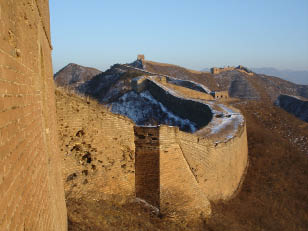Gubeikou Great Wall: Where History Comes to Life
Historical Significance
In my opinion, Gubeikou is the most beautiful section of the Great Wall in Beijing. The Wohu (Crouching Tiger) Mountain towers above while the ridge of the Panlong (Curling Dragon) Mountain snakes along. The Gubeikou Great Wall is divided into two segments by the Chaohe River. Every brick in those dilapidated walls, crude and unadorned, has the power to transport visitors back to the old times and lets them feel the Great Wall’s majesty endowed by history.
With continuing social development, excessive renovation and reconstruction can often mask the true face of history. From that perspective, the Gubeikou Great Wall is rare and precious because this section of the wall is as history left it, unrestored.
The history of Gubeikou can be divided into three phases.
 |
|
The Panlong Great Wall |
The first phase goes back to the period when the Song Dynasty fought the Jin regime of Jurchens (from the end of the 10th century to the beginning of the 11th century). The story that the warriors of the Yang family defended northern China is a classic that has been passed from generation to generation till today. Three generations of the family’s men had been commanders of the Song army, defending Song’s northern border. One of them died at the Gubeikou Great Wall, and it is said his tomb lies on the Wohu Mountain.
The second phase is charted during the Wanli Period of the Ming Dynasty from 1573 to 1620. At that time, Qi Jiguang, a famous militarist, was entrusted to build the Great Wall in Gubeikou and he personally participated in its construction. The segment of the wall that he oversaw is incomparable in terms of sturdiness and ingenuity. Today, a stele that marked Qi’s effort in building the Gubeikou Great Wall is preserved in the town’s exhibition hall. And an awe-inspiring statue of Qi stands high on Gubeikou Square.
The third phase is the war against Japanese intrusion in the 1930s. The Kuomintang 17th Corps launched a bloody battle in Gubeikou in 1933 to prevent the Japanese army invading Beijing.
